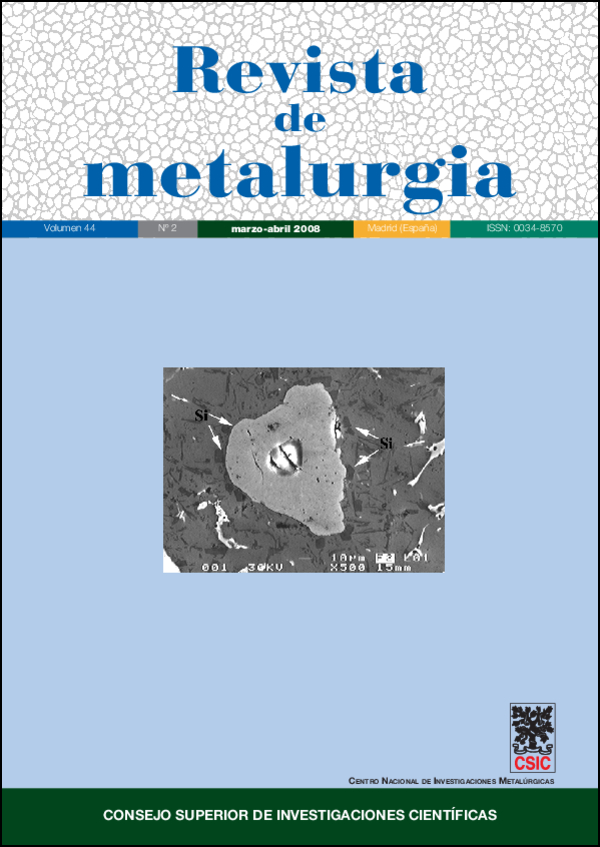Study of the mechanism of reaction during magnesium refining from molten aluminium alloys using SiO2 particles
DOI:
https://doi.org/10.3989/revmetalm.2008.v44.i2.102Keywords:
Aluminium alloys, Magnesium removal, Heterogeneous chemical reactions, Aluminium scrap recycling, Mechanism of reactioAbstract
An analysis of the results regarding the permanent contact reaction that occurs between the Mg dissolved in molten aluminum and SiO2 particles is presented. The experiments were carried out at constant temperature and molten metal stirring velocity. In the Scanning Electron Microscope, the crystallographic characteristics of the reaction products were determined using the Electron Backscattered Diffraction Technique, thus allowing to establish the stoichiometry and the mechanism of reaction. The results indicate that the mechanism of reaction is governed by Al, Mg, and Si ions diffusion through the layers of reaction products composed of MgAl2O4 and Al2O3 phases. It was found that during the process the composition of the reaction products changed as the concentration of Mg in the boundary layer diminished.
Downloads
References
[1] H.A.Oye, N. Mason Y R.D. Peterson, JOM 40 (1999) 29-42. doi:10.1007/s11837-999-0207-3
[2] L. Wang And M. Makhlouf, Int. Mater. Rev. 40 (1995) 221-238.
[3] C. Martínez, Tesis de Maestría, CINVESTAV, México, 1998.
[4] J.C. Escobedo, J.F. Hernández, S. Escobedo Y A. Flores, Rev. Metal. Madrid, 9 (2003) 171-182.
[5] A. Ghosh, Ritwik Sarkar, B. Mukherjee Y S.K. Das, J. Eur. Ceram. Soc. 1 (2003) 1-7.
[6] W.M. Zhong, G.L. Esperance Y M. Suery, Metall. Mater. Trans. A 26 (1995) 2.625-2.635.
[7] M. Fishkis, J. Mater. Sci. 26 (1991) 2.651- 2.661.
[8] B.C. Pai And S. Ray, Mater. Sci. Eng. 24 (1976) 31-45. doi:10.1016/0025-5416(76)90092-6
[9] M. Pfeifer, J.M. Rigsbee Y K.K. Chawla, J. Mater. Sci. 25 (1990) 1.563-1.567.
[10] J. Campbell, Castings, Butterwoth-Heinemann Linacre House, 2nd Ed., Jordan Hill, Oxford, UK, 2001, pp. 4-5.
[11] D.J. Lloyd, I. Jin Y G.C. Weatherly, Scr. Metall., 31(1994) 393–396. doi:10.1016/0956-716X(94)90006-X
[12] B. Hallstedt, Z.K. Liu Y J.Agren, Mater. Sci. Eng. A 129 (1990) 135–145. doi:10.1016/0921-5093(90)90352-4
[13] R. Molins, J.D. Bartout E Y. Bienbenu, Mater. Sci. Eng. A 135 (1991) 111-117. doi:10.1016/0921-5093(91)90546-Y
[14] A.D. Mcleod Y C.M.Gabryel, Metall. Trans. A. 23 (1992) 1.279-1.283.
[15] R.I. Sheldon, T. Hartmann, K.E. Sickafus Y A. Ibarra, J. Am. Ceram. Soc. 82 (1999) 3.293-3.391.
[16] O. Levenspiel, Ingeniería de las Reacciones Químicas, Editorial Reverté, 2a. Edición, Barcelona, España, 2002, pp. 406-415.
[17] W.M. Zhong, G.L. Esperance Y M. Suery, Mater. Charact. 49 (2003) 113-119. doi:10.1016/S1044-5803(02)00359-5
Downloads
Published
How to Cite
Issue
Section
License
Copyright (c) 2008 Consejo Superior de Investigaciones Científicas (CSIC)

This work is licensed under a Creative Commons Attribution 4.0 International License.
© CSIC. Manuscripts published in both the printed and online versions of this Journal are the property of Consejo Superior de Investigaciones Científicas, and quoting this source is a requirement for any partial or full reproduction.All contents of this electronic edition, except where otherwise noted, are distributed under a “Creative Commons Attribution 4.0 International” (CC BY 4.0) License. You may read here the basic information and the legal text of the license. The indication of the CC BY 4.0 License must be expressly stated in this way when necessary.
Self-archiving in repositories, personal webpages or similar, of any version other than the published by the Editor, is not allowed.
















